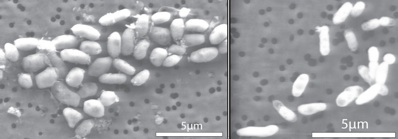
New discovery broadens definition of life
DR EMILY BALDWIN
ASTRONOMY NOW
Posted: 03 December 2010


Researchers conducting experiments in the harsh environment of Mono Lake in California have discovered a microorganism that is able to reproduce using the toxic chemical arsenic. The discovery opens up possibilities for life elsewhere in the Solar System.
"The definition of life has just expanded," says Ed Weiler, NASA's associate administrator for the Science Mission Directorate. "As we pursue our efforts to seek signs of life in the Solar System, we have to think more broadly, more diversely and consider life as we do not know it."
Mono Lake is known for its high salinity and high alkalinity – it is two and half times as salty and 80 times as alkaline as the ocean – along with high levels of naturally occurring arsenic. Its unusual chemistry results from it having been isolated from fresh water sources for some 50 years – any water that leaves the lake does so by evaporation alone.

Mono Lake, where microbes use arsenic to grow.
NASA Astrobiology Research Fellow Felisa Wolfe-Simon has been investigating the microbes that reside in the muds around the lake and in the water, to learn how they can thrive in such an extreme environment. All known life forms on Earth are built from six basic building blocks – carbon, hydrogen, nitrogen, oxygen, phosphorus and sulphur. Phosphorus contributes to DNA and RNA, which contain the genetic instructions for life but in the new life form, the microorganism substitutes arsenic for phosphorus, which is detrimental to most life on Earth.
"We know that some microbes can breathe arsenic, but what we've found is a microbe doing something new – building parts of itself out of arsenic," says Wolfe-Simon. "If something here on Earth can do something so unexpected, what else can life do that we haven't seen yet?"

Image of GFAJ-1 grown on arsenic (left) and phosphorus (right). Image: Jodi Switzer Blum.
The new microbe, known as strain GFAJ-1, is part of a common group of bacteria that researchers had taken from the lake to grow in the laboratory. The microbes were given a normal diet of sugars and vitamins, but were deprived of phosphate, the typically preferred form of phosphorous that life requires. The researchers then added arsenic to its diet instead, and found that the microbes continued to grow, having "learnt" to incorporate this chemical into its DNA.
"The idea of alternative biochemistries for life is common in science fiction," says Carl Pilcher, director of the NASA Astrobiology Institute. "Until now a life form using arsenic as a building block was only theoretical, but now we know such life exists in Mono Lake."
While the results don't necessarily mean we should go hunting for arsenic based life elsewhere in the Universe, it does mean that life is a lot more flexible than we realized.
|



